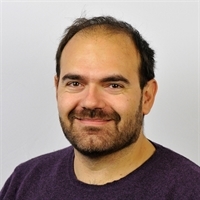Speakers
|
|
Melba Crawford
Purdue University |
Multi-modality Remote Sensing + Machine Learning in High Throughput Phenotyping of Row Crops High-throughput phenotyping using high spatial, spectral, and temporal resolution remote sensing (RS) data has become a critical part of the plant breeding chain focused on reducing the time and cost of the selection process for the “best” genotypes with respect to the trait(s) of interest. In this presentation, we investigate the potential of high resolution RGB, visible and near infrared (VNIR) and short-wave infrared (SWIR) hyperspectral data, as well as light detection and ranging (LiDAR) data acquired from UAV platforms for predicting characteristics of sorghum and maize. In addition to direct measurements of traditional phenotypes, these sensors potentially provide surrogate measurements for more complex plant structural characteristics and chemistry-based responses, inviting leveraging of both traditional and advanced capabilities in machine learning. We discuss opportunities and challenges associated with acquisition, processing, and analysis of multi-year data acquired at the Agronomy Center for Research and Education (ACRE) at Purdue University, USA. Examples include detection/counting, multi-modality predictive modeling of more complex phenotypes, and generalization of models across space/time. |
|
|
Artificial Intelligence for agricultural digital twins Digital Twins is a novel paradigm that provides previously unheard levels of control over physical entities and help to manage complex systems by integrating an array of technologies, including artificial intelligence, big data and internet of things. Digital Twins in agriculture are still emerging. This talk sketches the state of the art of digital twins in the agricultural sector, and presents some of our experiences in using AI for deploying for operational decision support in agricultural systems. |
|
|
|
Estimating Quantiles: An Informative Path Planning Approach to Guide Physical Sampling Marine scientists interested in studying natural phenomena or agricultural experts interested in crop health often take physical specimens for later analysis. The locations at which specimens are taken are typically specified by expert heuristics. Instead, we propose to choose locations for physical specimens suggested by a robot performing an informative path planning survey. The survey is designed to extract locations that correspond to the quantile values of some distribution of interest. We develop a robot planner using novel objective functions to improve the estimates of the quantile values over time and an approach to find locations which correspond to the quantile values. We demonstrate our approach on two different environments in simulation using previously collected aquatic data and validate it in a field trial that simulates some aspects of a crop health monitoring task. Our proposed approach to estimate quantiles has a 10.2% mean reduction in median error when compared to a baseline approach which attempts to maximize spatial coverage and is able to localize these values |
|
|
|
Towards self-supervised learning for geospatial data Recent technological developments are creating new data streams that contain a wealth of information relevant to sustainable development goals. Modern AI techniques have the potential to yield accurate, inexpensive, and highly scalable models to inform research and policy. A key challenge, however, is the lack of large quantities of labeled data that often characterize successful machine learning applications. In this talk, I will present new approaches for learning useful spatio-temporal models in contexts where labeled training data is scarce or not available at all. I will show applications to monitor agricultural productivity and landcover changes. |



